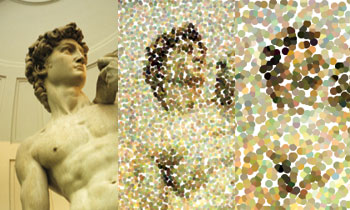
To be thought a geek? To actually be a geek?
To understand new media better? How about because information, not
matter, may be the basic substance of reality. Sound implausible? Read
on. Consider the following questions, asked by Baylor University computer science prof Robert Marks II:
• When a paper document is shredded, is information being
destroyed? Does it matter whether the shredded document is a copy of an
un-shredded document and can be replaced?
• Likewise, when a digital picture is taken, is digital information being created or merely captured?
• The information on a DVD can be measured in bits. Does the
amount of information differ if the DVD contains the movie Braveheart
or a collection of randomly generated digital noise?
• When a human dies, is experiential information lost? If so, can birth and experience create information?
• If you are shown a document written in Japanese, does the
document contain information whether or not you know Japanese? What if,
instead, the document is written in an alien language unknowable to man?
The purpose of such questions is to help us see that information is
real even though it is immaterial. One consequence of information being
immaterial is that it is not measured in any way commensurate with
material nature.
Matter can be measured in grams and energy in joules, but information
is measured in bits and bytes, which bear no relation to grams or
joules. One consequence is that we often ignore information when we
consider life in our universe, even though the primary way that life
forms differ from non-living forces or materials is the huge amount of
information they embody.
Information differs from matter in a number of ways; Here are three, to set us thinking:
1. Information is fundamentally a relational notion, that is, it
exists as a relationship between realized and unrealized possibilities.
As information theorist William Dembski explains, information is created
by ruling out possibilities. A remembered numerical code is the one
possibility among thousands that turns off an alarm system. Everything
about the system is material except the series of numbers that controls
it.
2. Generally, information increases when we increase its resolution,
and decreases when we decrease it (see David, above). A person may be
said to live in Canada, in the province of Saskatchewan, in the city of
Saskatoon, on Fifth Avenue, at No. 438, Unit 1314. In the increasing
resolution, nothing has changed about where the person lives; what
changed is the amount you know about where to find that person. We can
observe from this that information is relational, not causal. Knowing
the address does not cause you to contact the person, it only makes it
possible.
3. Information can be stripped of all matter and transmitted
immaterially from one medium to another but cannot be reduced to matter.
As great physicist John Wheeler put it, we get the “it” from the “bit,” not the other way around. Or, as quantum theorist Max Planck put it,
As a man who has devoted his whole life to the most clear
headed science, to the study of matter, I can tell you as a result of my
research about atoms this much: There is no matter as such. All matter
originates and exists only by virtue of a force which brings the
particle of an atom to vibration and holds this most minute solar system
of the atom together. We must assume behind this force the existence of
a conscious and intelligent mind. This mind is the matrix of all
matter. – Das Wesen der Materie [The Nature of Matter], speech at
Florence, Italy (1944) (from Archiv zur Geschichte der
Max-Planck-Gesellschaft, Abt. Va, Rep. 11 Planck, Nr. 1797); Max Planck
(1858–1947), the originator of quantum theory, The Observer, London,
January 25, 1931
This isn’t mysticism or woolly-headedness; it is just a fact. New
media help us see this fact more clearly because of the way they seem to
dispense with time and space. I’ll come back to this now and again in
future posts, because new media are easier to adapt to and manage if we
think in terms of information flow in media, rather than the materials
through which it is flowing.
See also: Data Basic I, II, and III for more information
.
Denyse O’Leary is a Canadian journalist, author, and blogger. Follow me at Twitter!

This article is published by
Denyse O'Leary
and MercatorNet.com under a Creative Commons licence. You may
republish it or translate it free of charge with attribution for
non-commercial purposes following
these guidelines. If you teach at a university we ask that your department make a donation. Commercial media must
contact us for permission and fees. Some articles on this site are published under different terms.

Forgot password?
Close message
Subscribe to this blog post's comments through...
Subscribe via email
SubscribeComments
Post a new comment
Comment as a Guest, or login:
Go back
Connected as (Logout)
Not displayed publicly.
Connected as (Logout)
Not displayed publicly.
Comments by IntenseDebate
Reply as a Guest, or login:
Go back
Connected as (Logout)
Not displayed publicly.
Connected as (Logout)
Not displayed publicly.